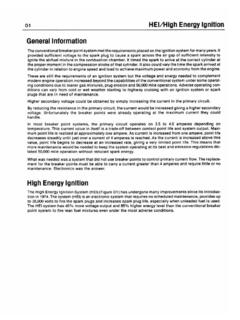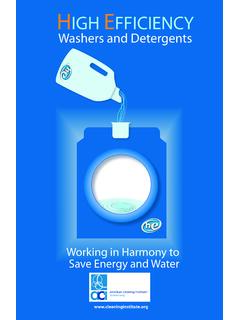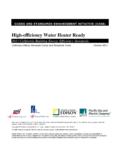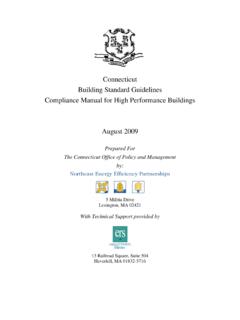Transcription of ENERGY SECURITY BOARD National Energy …
1 1 ENERGY SECURITY BOARD National ENERGY Guarantee: high Level Design Document 20 April 2018 2 Dr Kerry Schott AO INDEPENDENT CHAIR ENERGY SECURITY BOARD Clare Savage INDEPENDENT DEPUTY CHAIR ENERGY SECURITY BOARD Paula Conboy CHAIR Australian ENERGY Regulator John Pierce AO CHAIRMAN Australian ENERGY Market Commission Audrey Zibelman CEO & MANAGING DIRECTOR Australian ENERGY Market Operator 3 4 Contents EXECUTIVE SUMMARY .. 6 1 Introduction and next steps .. 10 Background to the consultation 10 Purpose of this paper .. 10 Consultation process .. 10 Structure of this consultation paper .. 11 2 Context.
2 12 Overview .. 12 A transforming ENERGY system .. 13 Reliability vs SECURITY .. 15 Australia s emissions reduction policy objectives .. 15 Contracting in the NEM .. 16 3 Emissions reduction requirement .. 19 Overview .. 19 Calculating the emissions intensity target .. 20 Applying the emissions reduction requirement .. 20 Flexible compliance 23 Reporting and compliance .. 25 Other Considerations .. 26 4 Reliability requirement .. 29 Overview .. 29 Step 1: Forecasting the reliability requirement .. 33 Step 2: Updating the reliability requirement .. 33 Step 3: Triggering the reliability obligation .. 34 Step 4: Liable entities.
3 34 Step 5: Qualifying contracts .. 35 Step 6: Procurer of last resort .. 37 Step 7: Compliance .. 38 Step 8: Penalties .. 39 Other considerations .. 40 5 The Guarantee: impact on affordability and competition .. 41 Affordability .. 41 Competition in the NEM .. 42 The extent of market concentration in the NEM .. 44 6 Governance of the Guarantee .. 47 Implementation through NEM governance arrangements .. 47 5 Relevant Commonwealth legislation .. 48 Summary of key steps and issues .. 48 A Abbreviations and defined terms .. 50 B State renewable schemes .. 51 6 EXECUTIVE SUMMARY Over the past fifteen years the ENERGY sector has undergone a significant transformation.
4 New and evolving technologies are changing the way we consume and produce electricity. This transformation of the sector continues with many technologies currently maturing and competing with traditional technologies while new and emerging technologies (for example, batteries) look likely to further revolutionise the sector. While undergoing this transition has had many positive benefits, it has also left our ENERGY system vulnerable to escalating prices while being both less reliable and secure. The National ENERGY Guarantee (Guarantee) provides the opportunity to resolve fifteen years of ENERGY and climate policy instability. It is designed to integrate ENERGY and emissions policy in a way that will encourage new investment in clean and low emissions technologies while allowing the electricity system to continue to operate reliably.
5 The Guarantee will provide a clear investment signal, so the cleanest, cheapest and most reliable generation (or demand response) gets built in the right place at the right time. Alone the Guarantee cannot solve all the challenging policy issues that the electricity sector currently faces. As recommended in the Finkel review, ENERGY SECURITY BOARD members are also continuing to explore a range of other complementary measures including strategic reserve/s, demand response and day ahead markets to ensure we have the operational flexibility we need in the rapidly changing electricity market. A well-designed Guarantee will bring together climate and ENERGY policy for the first time in Australia contributing towards resolving all three aspects of the policy trilemma maintaining reliability, lowering emissions in line with international commitments, and improving affordability.
6 Providing long-term policy confidence is critical to lowering investment risk in the NEM and ultimately bringing down electricity prices. The Guarantee will require retailers to support a range of different generation technologies through their contracting. Increased contracting in deeper and more liquid contract markets is expected to reduce the level and volatility of spot prices. In general, the greater the extent of competition in the retail and generation sectors, the more likely consumers are to benefit from all three objectives of the Guarantee. The Guarantee has been specifically designed to ensure it does not undermine but rather enhances the liquidity, transparency and level of competition in the retail and wholesale electricity markets.
7 The reliability and emissions reduction components complement one another, working together to ensure the market has a fair opportunity to deliver adequate reliability whilst lowering emissions. Retailers are expected to contract in a variety of ways to meet both of these requirements. Cognisant of the risks to liquidity and transparency in the contract market the ESB has sought to ensure that the contracting approach to meet compliance remains flexible. Emissions requirement The emissions reduction requirement ensures that the Guarantee works in a way that is integrated with existing electricity market operations without compromising financial market liquidity.
8 The ESB is recommending a generation and emissions reallocation approach that draws on existing reporting obligations, through the National Greenhouse ENERGY Reporting Scheme (NGERS). Incorporating this data into a registry and allowing a mechanism for retailers to have the generation and associated emissions allocated to them provides an 7 efficient approach to providing retailers with the infrastructure necessary to demonstrate their compliance. Under this approach, retailers will continue to enter into financial contracts to hedge their position in the spot market and manage any obligations under the reliability requirement of the Guarantee.
9 They can then use their existing contracts, or enter into new ones, to obtain the right to assign generation and any associated emissions for the purpose of the emissions reduction requirement. This could be done in any way the retailer deems appropriate. The retailer would submit to the registry the volume of output from a generator to which they have obtained the rights. This would operate in a similar way to AEMO s Reallocation Request Service platform which has operated under the National Electricity Rules since 2007. What a retailer submits to the registry (X volume from Y generator) can be based on any contractual arrangement held with a counterparty outside the registry, as long as both counterparties verify the claim in the registry.
10 At the end of a compliance period, once NGERS emissions data has been reported, the registry would automatically match up the emissions to a retailer based on the allocated generation volumes and associated emissions recorded in the registry. The Regulator would compare the average emissions intensity of the retailer against the electricity emissions target in assessing compliance. Reliability requirement The reliability requirement also builds on existing spot and financial market arrangements to facilitate investment in dispatchable capacity. The ENERGY SECURITY BOARD has identified eight key steps to a reliable electricity supply: 1.







